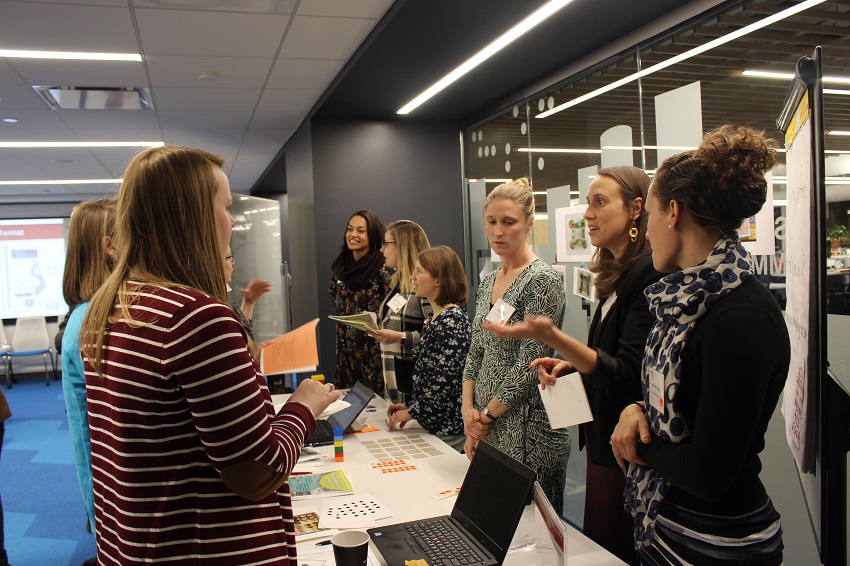Research & Insights / By Teachers for Teachers: Learning and Growing as Math Educators
By Teachers for Teachers: Learning and Growing as Math Educators

By Heidi Fessenden, Maggie Roth, and Michelle Sirois
“I figured out in 5 minutes there are 300 seconds, then I didn’t get any farther than that.”
“I was trying to come up with the rate of speed.”
“I said 12 second per kid.”
“__?_ _of 60 equals 20 seconds. Does that make sense? I don’t know!”
“Wait, wait. Didn’t we just figure out how long it takes to say a child’s name?”
The buzz in the room is palpable as teachers work in small groups to solve the High School Graduation Task, a problem about how long it takes to read out names at a graduation. These teachers, special and general educators in grades 2-8, come from a variety of schools in the Boston area, both traditional public and charter schools. Most of them have joined this class, hosted by and paid for by the Boston Teachers Union, with a colleague from their school so that they can plan together and observe each other back at school in between sessions. This is their first day doing math together.
The course they are taking is called Bridging Classrooms with Peer Learning Partners. It was designed and led by the six of us who all are Boston teachers and were 2017 EdVestors Zeroing in on Math Fellows. This course was the project we chose to work on throughout our year-long fellowship. After reading research from Deborah Ball about the importance of pedagogical content knowledge for teachers, we knew we wanted to design a math course by teachers, for teachers. Heather Hill presented to the Math Fellows her research showing that when teachers do math together, the impact on student outcomes is greater than that of most other kinds of professional development. We knew then that we wanted teachers to collectively engage in mathematical tasks and routines and to reflect on those mathematical experiences with a “student hat” and a “teacher hat.” (See sidebar for examples of “Student Hat” and “Teacher Hat” reflection questions.)
As teachers reflected on their experiences as learners during the first session, the power of doing math together coupled with reflection was validated.
“It was interesting, we were in such a hurry to solve that we missed some major elements - and that’s exactly what the kids do. But we had two people in the group that asked, ‘What questions are we supposed to answer?’”
“What was cool is that everyone approached it a different way."
“We had such different strategies that I could not even listen to what she was saying, but then I was scribing for our poster. The act of writing it and having to convey her ideas with my hand forced me to understand it a little bit more.”
In these initial reflections, teachers saw connections between their own habits and those of their students, appreciated the value of sharing a variety of math strategies, and considered teaching structures that support mathematical understanding.
With a bit of trial and error, we crafted a simple structure that we used for most of the five sessions. Less is more, we learned. The structure was:
- Sharing: Each session began with sharing of teacher work and reflections since the last session.
- Math task or instructional routine: Teachers participated in an instructional routine or engaged in a math task as if they were students. We facilitated these the way we might lead them in our own classrooms.
- Reflection: Teachers reflected on the mathematical experience from the perspective of students (Student Hat), then thought about how they would use the task, routine, protocols, or class structures in their own work (Teacher Hat).
- Planning: Teachers worked with their learning partner to plan a lesson inspired by that evening’s experience.
- Intentions: Each session closed with teachers naming an intention of something they would try in their classrooms before the next session.
For providers of Professional Development, a common problem is decreasing attendance over the weeks of a class. One of the first signs that Bridging Classrooms was going well was that, of the 13 participants who came to Session 1, all returned for Session 2, and one brought a colleague. We did not lose any participants over the course of the five sessions. The work we did during the five sessions together was inspiring. Though we were technically teaching and facilitating each session, we were learning and growing alongside the teachers in our course. Each of us did the math with the participants and had the same "a ha!" moments as we learned from each other. We never could have anticipated how much this course shifted not only our participants' practice, but our own, too.
Melissa Frascella (Math Dept Chair / Eighth grade math teacher, Boston Collegiate Charter School), Meredith Hart (Sixth grade teacher, Haley Pilot School), and Alia Verner (Math Director / Instructional Coach, TechBoston Academy) also contributed to this work and blog post.



